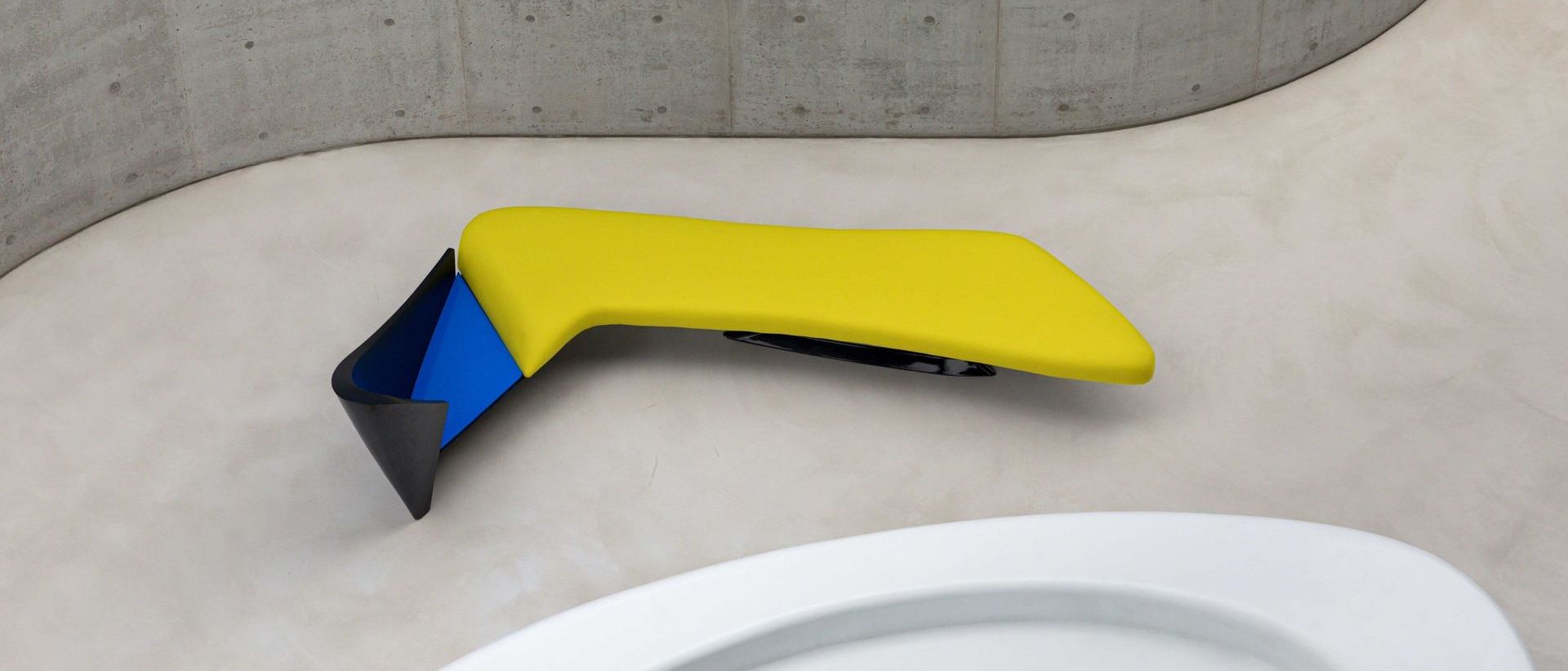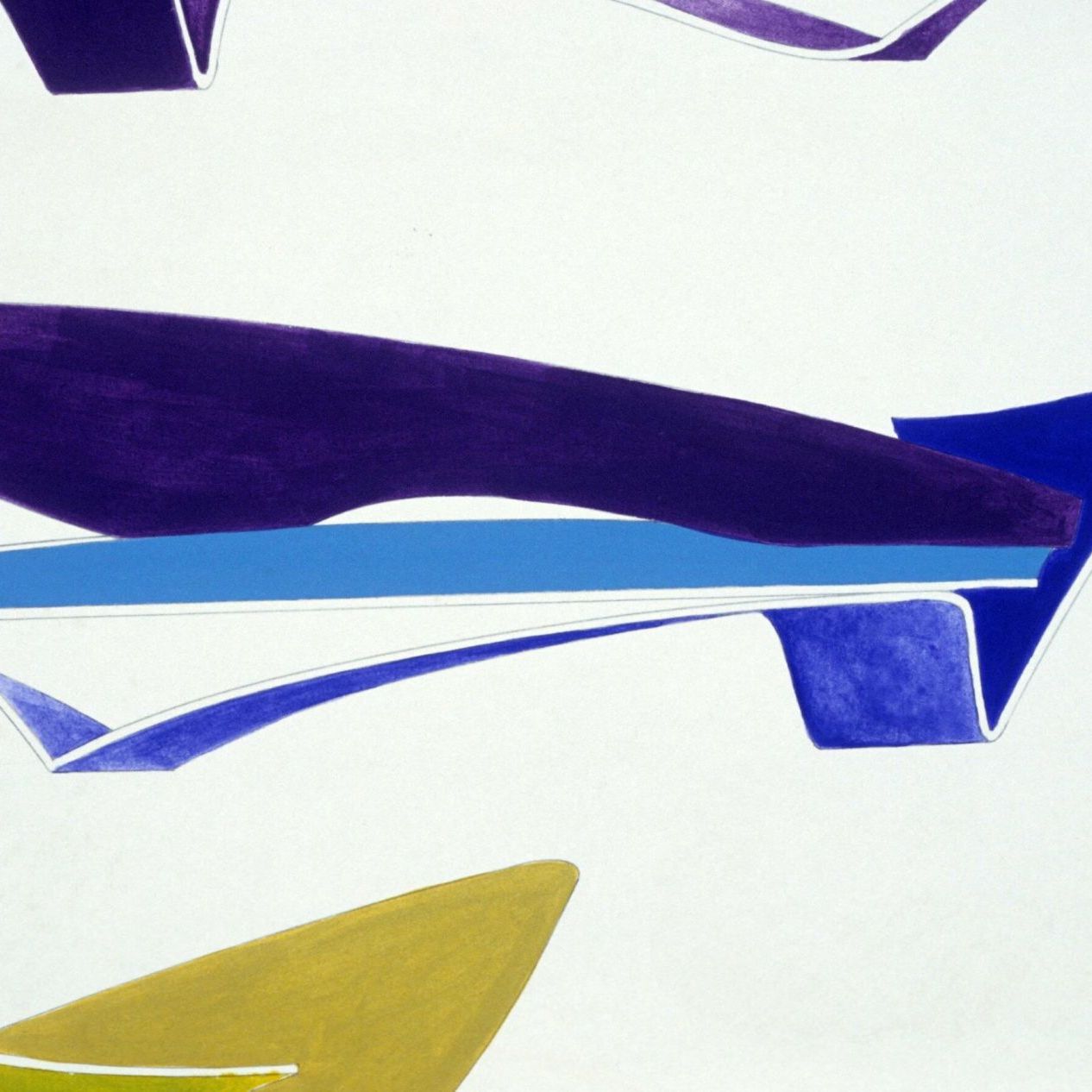
Wavy. The Zaha Hadid sofa photographed inside Maxxi.
October 2023
Gloria Mattioni
Zaha Hadid
The first collection for Edra created by the Iraqi architect at MAXXI after more than XXX years
Zaha Hadid was the first woman architect to receive the prestigious Pritzker Prize in 2004 - an extraordinary achievement considering the largely male-dominated industry in which she worked. Born in Baghdad, but a Londoner by adoption, she was a pure legend even before her sudden death in 2016. She has left an indelible mark on the way we conceive space, designing structures with undulating surfaces of concrete and glass that demolish our preconceptions and even redefine geometric theorems. She was also the first woman to design an American museum, the new Lois & Richard Rosenthal Center for Contemporary Art in Cincinnati, Ohio, which opened in 2003. More than anything else, she is a revolutionary figure, a great visionary. With her curvy lines, she helped undermine what remained of the obsolete rigidity of much architecture.
To the Eternal City she gave the MAXXI museum in Rome, for which she received the Stirling Prize from the Royal Institute of British Architects, in addition to other prestigious awards such as the Mies van der Rohe Award. ‘I’m particularly fond of this museum’, Zaha Hadid said, ‘because it’s a contemporary building in an ancient city and it was exciting to build in an environment where there are many layers, using the latest technology in such a beautiful setting to combine past and present.’ The museum in Rome is a perfect example of her concept of integrated architecture, based on the interrelation between the design, the region and the topography: ‘it helps to think of these buildings as living spaces. Today people are hungry for public spaces where they can meet as they used to in the village square. These are spaces for the community. Museums play an important role because not everyone has the opportunity to travel. They serve to provide high-level local cultural activities.’
At MAXXI, Edra put together the extraordinary photo shoot that illustrates these pages, featuring pieces from the collection designed by Zaha Hadid and produced by the company in 1988. ‘She was capable of designing on different scales with the same sensitivity’, says Monica Mazzei.
We were fascinated to see how she was able to translate her language from architecture to furniture, how the curved lines that define the rooms also characterise the objects.
These sculpture-like objects looked like micro architecture, really reducing down the scale. The photos show the dialogue between the pieces in the collection and the museum.’
The collection includes three sofas, Red, Woush and Wavy, and a large table, Metal Carpet. It was Zaha Hadid’s first venture into product design. A production challenge into which the newly established Edra threw itself enthusiastically. The company was determined to translate the fragmentary geometries and sense of movement inherent in the designs of the ‘Queen of the curve’ and the ‘inventor of the 89-degree angle’ into new objects for living.
Back then, she was known as a ‘paper’ architect. Despite the appreciation and admiration of famous colleagues such as Daniel Libeskind or Elia Zenghelis and Rem Koolhas, with whom she worked as a partner at the Office for Metropolitan Architecture before establishing her London office, her projects never came to fruition. They conquered hearts, but were considered too avant-garde to move from design to construction. An obstacle that had not been overcome even in 1983, when she won international fame by winning the competition for the design of a leisure and entertainment centre in Hong Kong, The Peak. It was a sort of ‘horizontal skyscraper’ that served to establish her aesthetic, inspired by Kazimir Malevich and the Russian Suprematism movement.
Showing exceptional determination, she was not put off and continued to design, filling entire notebooks with new drawings. Her pencil was as irrepressible as her imagination. ‘Design is a lens that reveals otherwise imperceptible aspects’, she said. ‘It’s a method of understanding how things can change and evolve and it serves not to definitively crystallise a form, but to demonstrate the possibility of becoming.’ From the initial black and white sketches, she soon moved on to the richness of colour, adding new nuances, depth and shades: ‘every time I do a drawing, my vision of the building changes. Colouring is a kind of test that helps to define the final configuration of the architecture.’ Her designs are collected as paintings and have been exhibited in several art museums. Finding photos and drawings from the time she collaborated with Edra in the company archives seeing now the products at MAXXI was a hugely emotional experience.
Hadid’s insatiable curiosity and desire to explore spatial relationships on all scales was the launch pad for designing the furniture for her London home, a small flat in the former royal stables that had a number of issues. Her conception of interiors derived from an urban vision in which space remains the real protagonist, interacting with the furnishings in a dynamic way.
She was not interested in designing functional objects. She wanted to provoke emotions.
Emotions like those she experienced in Moscow’s Red Square: ‘there, buildings from different historical periods coexist magnificently’, she said. ‘St Basil’s Cathedral, the GUM department store, the Kremlin and Lenin’s Mausoleum are all high-quality buildings, born out of a precise intention. It’s the intensity of their design that makes the whole thing harmonious.’ Thus, the first sofa was born, Woush, which Hadid had built by a London craftsman. Then there was the incredible table, Metal Carpet, that seemed to have arrived from the set of 2001: A Space Odyssey.
‘In the summer of 1987’, says Edra President Valerio Mazzei, ‘Casa Vogue published photos of her house. Massimo Morozzi and I were fascinated by the harmony of the volumes and the dynamism of the furniture in its relationship with space. We decided to fly to London to meet her and propose a collaboration.’ The first impression remained unchanged in the meetings that followed:
‘she was a person of extraordinary sweetness. Many considered her hard and rigid, but it was her way of defending herself, born of perfectionism, of the desire to cross boundaries that architecture and engineering had never crossed before.’
‘Meeting her could not leave anyone indifferent. She was intense, curious, determined but shy, very instinctive but also extremely rational. The first time she came to visit us in Tuscany, she asked to be taken to see the Calambrone camps, built by Mussolini. She was fascinated by fascist architecture, to which she had devoted part of her degree thesis. As soon as she came to discuss a project in concrete terms, all her charisma emerged’ confirms Monica Mazzei.
The collection also included the Wavy sofa, designed for a friend of hers in London, and the Red sofa, which she designed exclusively for Edra. The production of the four elements presented a number of difficulties. ‘At that time, CAD didn’t exist’, explains Leonardo Volpi, from Edra’s R&D laboratory, ‘so, in the absence of right angles, straight lines or at least broken lines - everything was curved - the reference points for matching the various parts were achieved thanks to a series of models made of solid wood by a very good craftsman. Casts were made from these models for the fibreglass moulds created by a company that made decks for shipyards.’
Combining the most advanced technologies with manual intervention is a fundamental principle of Edra’s philosophy. ‘Everything was less than easy’, recalls Valerio Mazzei, ‘from the design of the base of Metal Carpet, which had to support a 150-kilo glass top more than five metres long, to the “pointillist shading” obtained with an airbrush to go from almost black to white by “painting” the special fabric designed by her and made exclusively for us, which covers the Woush. The costs far exceeded the turnover for that year, 1988. But when we presented the collection at the Rolling Stones in Milan in September, the success of the party exceeded all expectations. There were so many people waiting to get in that the line stretched along most of Corso XXII Marzo.’
In September of that year, I was living in Milan but was in New York on business. The echoes of that legendary party had even made it all the way over there. They continued to be heard for a long time. The debate on the need for dialogue between design and architecture was reinvigorated, and the newly founded Edra affirmed its vocation as a discoverer of new talent. 1988 was also the year Hadid entered MOMA in New York, participating in an exhibition entitled ‘Deconstructivist Architecture’. It was a major achievement, but the labels were too narrow for her. When asked how she would define her own style, she would reply: ‘virtuoso of elegance, research and personal enquiry.’
The architectural projects left unfinished at her death continue to be completed by her studio, led by her lifelong business partner, Patrick Schumacher, who is now designing a very high-speed train for the Italian company Interloop, which will reduce the 40-minute journey of the Malpensa Express to just ten minutes. Zaha Hadid’s legacy extends beyond the boundaries of architecture and furniture. Her desire to experiment with materials, technologies, volumes and shapes also encouraged her to design sets for theatrical performances and collaborate with fashion houses such as Chanel and Louis Vuitton. She designed clothes and accessories as structured as her buildings and wore them as soon as she could. In 2006 she founded Zaha Hadid Design as a separate design business, to take on all collaborations and special projects excluding architectural work. Even today, co-directors Maha Kutay and Woody Yao continue their journey through their unique and timeless, bespoke and limited edition pieces, as well as through their acclaimed collaborations with global design companies such as Bulgari, Swarovski, Georg Jensen to name a few. In 2016, Zaha Hadid, a few months before her death, she attended the reception ceremony for the Gold Medal awarded to her by the Royal Institute of British Architects completely dressed in black, her favourite colour, and wrapped in a cloak tessellated like a mosaic of various overlapping geometries. Three years earlier, in 2013, during the Paris fashion shows, she caught the eye with a pair of chrome-plated metal ankle boots with 16-centimetre heels and striated surfaces, designed in 3D-CAD and imitating the overlapping of geological strata (an idea that had already inspired her Galaxy Soho in Beijing), produced for United Nude in a limited edition: sculptures to wear, expressing her futuristic vision also in style.
.png) |
Gloria Mattion She is a writer, journalist and communication consultant for companies in the sector. She lives in California, where she moved many years ago and where she pursues her passion for American modernism in architecture. She is the author of books published in Italy and the United States and is a correspondent for several European magazines. |
















